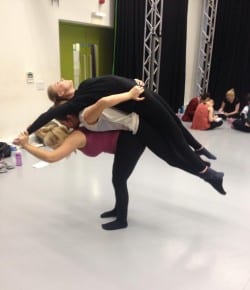This week’s reading was based on the experience and knowledge of touch. I found the reading useful as it inspired me during the class. The reading looked at ‘experience of touch as an embodied form of social interaction’ (F, Bannon, 2012, 215). The reading helped me understand the aspect of giving weight, as it spoke about the potential to become absorbed in multidirectional interrelationship between partners. I found this was the case when giving weight. Becoming fully absorbed in the moment giving all my weight to my partner. The reading then goes on to talk about the complexity of touch. Intriguingly, touch is viewed as a subject of power within the article. Stating that touch can potentially cause unequal power between dancers. This I found useful, to help me understand that taking someone’s weight can be just as powerful as giving weight.
Coming into week 2, I felt positive and excited about the module. We started the lesson by exploring with weight not only with the floor but also giving others part of our weight. We were taught the most effective and efficient ways in which we could give someone our weight. The exercise started with me laying along the floor whist my partner lay across me. She then used a method of rolling up and down my body experimenting where it was good to give more weight, and to notice the areas in which she had to take more of the weight such as the knees and the head. During this exercise I felt very relaxed almost as though I was been given a massage. I had total trust in my partner. When the roles changed and it was my turn to give my partner my weight I felt very conscious to whether I was giving too much or too little. After several practices I felt myself becoming more relaxed, and almost found it difficult to distinguish between my body and my partners.
Onwards from this we went on to develop the exercise. Instead of just the over person rolling along their partner the under person was to also roll. Kayla described this as ‘catching the wave’ which helped to understand the task. I found the exercise fairly difficult when trying to ride the wave. It was fairly difficult to concentrate on being conscious to certain body parts. Whilst waiting for the right time to ride the wave. We then were asked to use different body parts to lead the roll with. The body part which challenged me the most was leading with the head. I felt very weary doing so with such a precious part of the body. But as time went on I felt more comfortable and trusted my partner more. I found the exercise fun as it allowed me to let go and fully give my weight to my partner trusting her to take my weight.Finally we went on to giving our weight whilst performing movement. To do this the non-moving partner asked the moving partner to stop in a statuesque position which they felt created a base for them to balance on or against. As a base I made sure I took my partners weight in the most efficient place such as the hands. Changing roles, I was conscious of when to give more weight or restrain from giving too much weight in order to create a sturdy balance. Throughout the exercise me and my partner both experimented with different positions and dared to fully rely on one another to take each other’s full weight. I found both exercises during class challenging however beneficial to understand the importance of giving weight safely and efficiently.
During the jam this week I felt more comfortable and familiar with the setting starting with a Pow-Wow, and moving onto finding our kinesphere and skinesphere by rolling along the floor, changing direction as we do so. As the jam moved forwards I found myself rolling amongst people I don’t usually work with, experimenting with giving weight and taking weight. I often felt cautious of giving too much weight, therefore, I would restrain myself to do so. However, towards the end of the jam I found myself becoming more comfortable with the aspect of giving weight, creating a trust between me and the other dancers.
